
This short video covers many anatomical terms.
- Subject:
- Anatomy/Physiology
- Life Science
- Material Type:
- Activity/Lab
- Author:
- Bruce Forciea
- Date Added:
- 06/03/2021

This short video covers many anatomical terms.
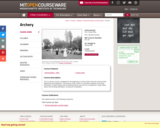
This 12 session course is designed for the beginning or novice archer and uses recurve indoor target bows and equipment. The purpose of the course is to introduce students to the basic techniques of indoor target archery emphasizing the care and use of equipment, range safety, stance and shooting techniques, scoring and competition.
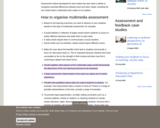
Guidance on critiquing and grading multimedia assigments. This guide provides nine tips for understanding and organinzing the structure of multimedia assessment.

This video covers using the Blackboard Learn Ultra AI Design Assistant to auto-generate suggested course content in the form of Learning Modules.
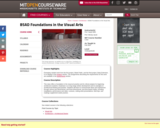
Offers a foundation in the visual art practice and its critical analysis for beginning architecture students. Emphasis on long-range artistic development and its analogies to architectural thinking and practice. Learn to communicate ideas and experiences through various two-dimensional, three-dimensional, and time-based media, including sculpture, installation, performance, and video. Lectures, visiting artist presentations, field trips, and readings supplement studio practice. Required of and restricted to Course 4 majors. Lab fee.

This set of course materials includes lecture slides, activity files, images, quizzes, tests, review questions, and project assignments for Digital Media at Georgia Gwinnett College. The course uses open-source applications such as GIMP and InkScape.
Individual chapters are available for download due to the large file sizes. Web-based assignments to supplement these materials are located on the GGC Wiki: All Digital Media Assignments
Topics covered include:
Digital Images
Image Processing
Audio Processing
Video Processing
Creating Animation
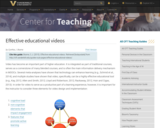
Unlock the key components and strategies for designing and implementing educational videos that truly captivate and educate. Learn about essential elements, such as storytelling, visuals, and pacing, that elevate the effectiveness of educational video content.

This course concentrates on close analysis and criticism of a wide range of films, including works from the early silent period, documentary and avant-garde films, European art cinema, and contemporary Hollywood fare. Through comparative reading of films from different eras and countries, students develop the skills to turn their in-depth analyses into interpretations and explore theoretical issues related to spectatorship. Syllabus varies from term to term, but usually includes such directors as Coppola, Eisentein, Fellini, Godard, Griffith, Hawks, Hitchcock, Kubrick, Kurosawa, Tarantino, Welles, Wiseman, and Zhang.

A collection of resources on image copyright and fair use.
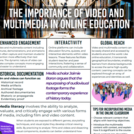
A handout that provides key areas in which the use of multimedia in online education is helpful and important, including: student engagement, interactivity, global reach, media literacy, the benefits of the flipped classroom, and movies and video as historical record It also provides tips for using multimedia in online education.

Recognize when to use integration by parts.
Use the integration-by-parts formula to solve integration problems.

This workshop is designed to introduce students to different perspectives on politics and the state of the world through new visualization techniques and approaches to interactive political gaming (and selective 'edutainment.') Specifically, we shall explore applications of interactive tools (such as video and web-based games, blogs or simulations) to examine critical challenges in international politics of the 21C century focusing specifically on general insights and specific understandings generated by operational uses of core concepts in political science.

This video covers an introduction and explanation of Expected Value and how to calculate it.

In this course students create digital visual images and analyze designs from historical and theoretical perspectives with an emphasis on art and design, examining visual experience in broad terms, and from the perspectives of both creators and viewers. The course addresses key topics such as: image making as a cognitive and perceptual practice, the production of visual significance and meaning, and the role of technology in creating and understanding digitally produced images. Students will be given design problems growing out of their reading and present solutions using technologies such as the Adobe Creative Suite and/or similar applications.

NOTE: Note, if you cannot see the materials, click "View Resource" and then click "Link" on the blank page which appears (or go directly to http://musictheory.tech).
This open educational resource (OER) textbook which is available at http://musictheory.tech contains an explanation of concepts from Music Theory I, II, III, and IV. It is supplemented by video explanations and online assessment activities. It is available at no cost for students and faculty of music theory so long as they use it according to the terms. The copyright notice must not be removed and the terms of distribution may not be changed. Derivative works are permitted under the same terms. Derivative works must be registered by email to editor@musictheory.tech. The concise nature of the materials makes them especially useful for those wishing to review theory concepts before taking an entrance exam, or for students needing out-of-class review of theory topics. The book and materials are under active development and suggestions for improvements are welcome! The materials were created with partial support from an OER grant from Tarleton State University. Floyd Richmond the author has taught college-level music theory I, II, III, and IV for 15 years to hundreds of students.
The supplemental videos and interactive assessments are found in the text but are extracted and listed online at http://musictheory.tech.
The following list of concepts extracted from the Table of Contents shows the scope of the textbook.
THEORY I
WHY IS MUSIC THEORY IMPORTANT
MUSIC THEORY THROUGHOUT HISTORY
WHICH NOTE TO PLAY
Staff, Clef, Treble (G), Bass (F), Alto (C), Tenor (C), Ledger Lines, Octaves
NAMING THE NOTES
ACCIDENTALS
Lines, Space, Accidentals, Sharps, Flats, Naturals, Double Sharps, Double Flats, Octave Numbers
RHYTHM
Note Shape, Heads, Stems, Beams, Rhythmic Names, Duration
STEM DIRECTION
Stem Direction, Special Cases, Center Line, Beamed Notes)
RHYTHMIC RELATIONSHIPS
Whole Notes, Half Notes, Quarter Notes, Eighth Rests, Sixteenth Notes
Whole Rests, Half Rests, Quarter Rests, Eighth Rests, Sixteenth Rests
PATTERNS AND COUNTING
One Beat Patterns, Two Beat Patterns, Kodaly, Gordan, Traditional
METER AND TIME SIGNATURES
Meter, Quadruple Meter, Triple Meter, Duple Meter, Conducting Patterns
PICKUP NOTES
Anacrusis, Conducting
MORE ABOUT TIME SIGNATURES
Common Time, Rhythmic Durations, Time Signatures with a 2, 4, or 8 on the bottom, Simple meter, 2/4, 3/4, 4/4
COMPOUND TIME SIGNATURES
6/8, 9/8, 12/8
DOTTED NOTE VALUES
Dotted Quarter/Eighth, Dotted Eighth/Sixteenth
TIES
SLURS
REPEATS
One-measure Repeats, Two measure Repeats, Simple Repeats, First and Second Endings, DC al Fine, DS al fine, DC al Coda, DS al Coda
MAJOR SCALES
Chromatic Scale, Major Scale, Solfege, do, re, mi, fa, sol, la, ti, do, Fixed and Movable do, Whole and Half Steps in a Major Scale
KEY SIGNATURES
Order of Sharps and Flats, Mnemonic Devices, Placement on the Staff, 15 Major Key Names and Number of Sharps and Flats
TONALITY
MINOR SCALES
Natural, Harmonic, and Melodic Minor Scales, Construction, 15 Mine Key Names and Number of Sharps and Flats
MODES
Minor Modes: Aeolian, Dorian, Phrygian; Major Modes: Ionian, Lydian, Mixolydian; Other Modes: Locrian; Other Scales: Pentatonic, Whole Tone, Octatonic, Pitch Class Set, Chromatic
INTERVALS
Consonant Intervals, Dissonant Intervals, Neutral Intervals, Melodic Intervals, Harmonic Intervals, Unison, 2nd, 3rd, 4th, 5th, 6th, 7th, Octave, Qualities of Interval: Major, Minor, Perfect, Diminished, Augmented, Doubly Diminished, Doubly Augmented, Listening to Intervals, Enharmonically Equivalent Intervals, Most Consonant, Neutral, and Dissonant Intervals, Inverting Intervals, Identifying Intervals, Constructing Intervals
SCALE DEGREE NAMES
Tonic, Supertonic, Mediant, Sub Dominant, Dominant, Submediant, Leading Tone, Sub Tonic
TRIADS
Major (Mm), Minor (mM), Diminished (mm), Augmented (MM), Arrangement on Scale Steps in Major Keys, Arrangement on Scale Steps in Minor Keys, Identifying Triads, Spelling Triads
CHORD SYMBOLS FOR TRIADS
Popular Music Conventions, Roman Numeral Conventions
TRIAD INVERSION
Root Position – Bass Note: Root, First Inversion (6) Bass Note: Third, Second Inversion (64) Bass Note: Fifth
HARMONIC PROGRESSIONS
Dominant to Tonic Movement, Circle of Fifths, . . . iii, vi, ii, V I . . .
CHORD SUBSTITUTIONS
Chords with Shared Notes, Common Chord Substitutions
MORE ABOUT CHORD PROGRESSIONS
Chord Substitutions in Major and Minor Keys, I64 as a dominant substitution, Cadential 64 Progressions
WRITING MUSIC
Rhythms, Melodies, Harmonies, Texture, Form
CREATING HARMONIES
Two Voices, Three Voices, Four Voices, Voice Leading Rules, Resolving Adjacent Chords, Resolving Chords with Tendency Tones
NON-CHORD TONES
Passing Tone, Neighboring Tone, Appoggiaturas, Escape Tones, Anticipations, Suspensions, Retardations, Pedal Tones, Suspension Numbers, Identifying, Constructing
CADENCES
Function of Cadences, Types of Cadences: Authentic Cadences, Perfect Authentic Cadences, Imperfect Authentic Cadences, Plagal Cadences, Half Cadences, Deceptive Cadences; Strength of Cadences
PERIOD AND PHRASE CONSTRUCTION
Phrases, Periods, Double Periods, Antecedent, Consequent, Parallel Construction
THEORY II
SEVENTH CHORDS
M7 (MmM), Mm7 (Mmm), m7 (mMm), Æ7 (mmM), °7 (mmm), Writing Quality with Popular and Roman Numeral Systems
SEVENTH CHORD INVERSION
Root Position (7), First Inversion (65), Second Inversion (43), Third Inversion (42), Popular and Roman Numeral Conventions, Seventh Chord Progressions, Substitutions, Doubling, Resolving, Identifying, Construction, Using 9th, 11th, and 13th Chords
SECONDARY DOMINANTS
Concept, Purpose, Circle of Fifths, Major and Minor Keys, Identification, Construction, Resolution
SECONDARY SEVENTH CHORDS
Concept, Purpose, Identification, Construction, Resolution
THEORY III
MODULATIONS
Pivot Chords, Common Tones, Direct Modulations
BORROWED CHORDS
PREDOMINANT CHORDS
Neapolitan 6 (N6), Augmented Chords: German (G+6), Italian (I+6), French (F+6), Other +6 Chords, Enharmonic Spelling, Identification, Constructions, Resolution, Secondary Augmented Sixth Chords
THEORY IV
LATE ROMANTIC AND IMPRESSIONISTIC PRACTICES
More Substitute Chords, ct°7, Parallel Chords, Planing, Chromatic Mediants, Whole Tone Scales, Octatonic Scales, Pentatonic Scales, Modal Scales, Modified Modal Scales, Making Dissonances Approachable
TWENTIETH CENTURY AND BEYOND
TWENTIETH CENTURY CLASSICAL MUSIC
Meter (Changing Meters, Asymmetric Meters, Bimetric, Polymetric), Tonality (Bitonality, Polytonality), Non-Tertian Harmony (Tone Clusters, Secundal Harmony, Quartal Harmony, Quintal Harmony), Pandiatonic Harmony, Minimalism, Expressionism/Serialism, Aleatoric Music, Prepared Piano, Music Concrete, Electronic Music
JAZZ
Origins, Influences, Vocabularies, Melodies, Rhythms, Expression, Harmony
POP MUSIC
Decades, Instruments (Folk, Clean Electric, Distorted Electronic, Keyboards, Bass, Drums, Vocals), Harmonies, Memorization, Modulations, Forms, Timbres
FORMS
Binary, Ternary, Round/Canon, Invention, Fugue, Passacaglia, Minuet, Theme and Variation, Rondo, Sonata Allegro, Tone Poem
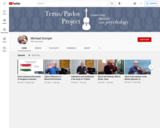
This YouTube channel hosts a series of short (about 15 min) talks and performances for the Pavlov/Tertis Project, which explores connections between music and psychology. The talks were written and delivered by Michael Domjan, Professor of Psychology at the University of Texas, who is an internationally recognized expert in conditioning and learning. Dr. Domjan also received training as a violist in the preparatory division of the Juilliard School of Music. In this series of videos, he combines his knowledge of psychology with his knowledge of music. Topics include How is psychology relevant to music, Neuroscience and music, Habituation and sensitization in the music of J. S. Bach, Types of memory in musical performance, Why is it harder to teach playing the violin. than playing baseball, What is a Tertis viola?, How is Pavlovian conditioning relevant to music?, Talent vs practice in musical expertise, Why is it important to practice a musical instrument, and What I learned in a music conservatory that made me a better scientist.

This video dives deeper into the concept of Expected Value and demonstrates how it can be applied to a few practice problems.

This video is additional practice problems on the applications of Expected Value and how to solve word problems.
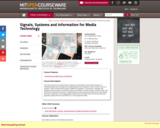
" This class teaches the fundamentals of signals and information theory with emphasis on modeling audio/visual messages and physiologically derived signals, and the human source or recipient. Topics include linear systems, difference equations, Z-transforms, sampling and sampling rate conversion, convolution, filtering, modulation, Fourier analysis, entropy, noise, and Shannon's fundamental theorems. Additional topics may include data compression, filter design, and feature detection. The undergraduate subject MAS.160 meets with the two half-semester graduate subjects MAS.510 and MAS.511, but Assignments and Labs differ."

A collection of resources used when producing live streaming content like commencement ceremonies. Critical questions to ask clients before live production.